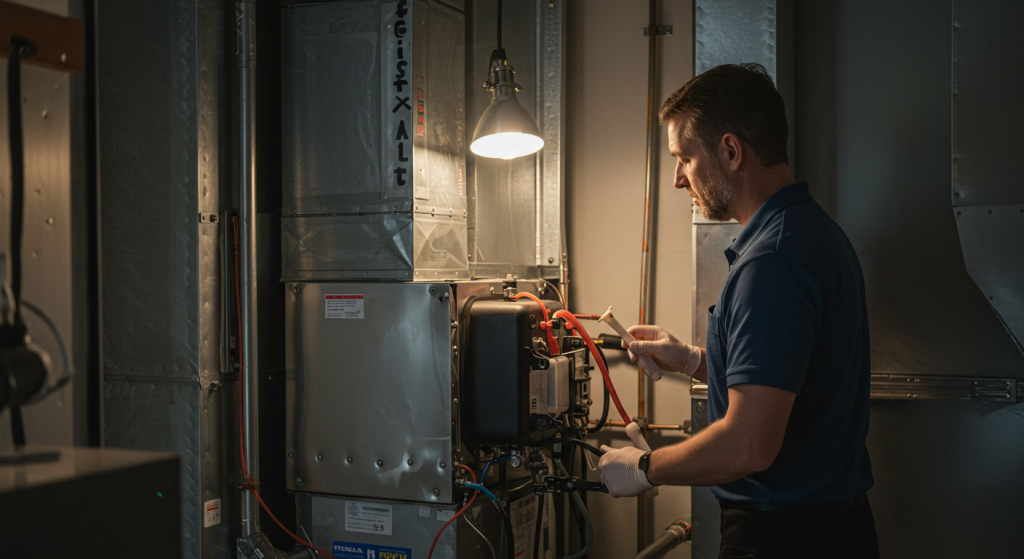
At Cheeky Heating, Cooling & Plumbing, we understand the importance of a well-functioning furnace during the chilly months in Cumming, GA. To ensure your home stays warm and cozy, here are our top tips to detect furnace problems before winter arrives:
1. Listen for Unusual Sounds
Unusual noises like screeching, rattling, or banging can indicate mechanical issues within your furnace. For instance, a screeching sound might suggest a problem with the motor or blower belt, while rattling could mean loose parts. If you notice any of these sounds, it’s essential to contact a qualified HVAC technician immediately to prevent further damage.
2. Inspect the Furnace Air Filter
A dirty air filter can reduce heating performance and increase energy bills. We recommend checking and replacing your furnace air filter monthly, especially during seasonal transitions, to maintain optimal efficiency. Regularly replacing the air filter helps keep dust and debris out, ensuring the furnace runs smoothly.
3. Test Your Thermostat
Switch your thermostat from cooling to heating mode before the cold weather hits. Raise the temperature setting by five to ten degrees and listen for the furnace to kick on within a minute. If it doesn’t, there may be an issue with the thermostat or its wiring, and it’s advisable to call an HVAC technician to diagnose and fix the problem safely.
4. Examine the Heat Exchanger
The heat exchanger is crucial for transferring heat while preventing exhaust gases from entering your home. A cracked heat exchanger can pose serious health risks by allowing harmful gases like carbon monoxide to leak. It’s best to schedule a professional inspection to check for any cracks or leaks. Additionally, installing carbon monoxide detectors adds an extra layer of protection.
5. Look for Cold Spots in Your House
Uneven heating or cold spots can indicate issues with your HVAC system, such as blocked vents or improperly sized ducts. Identifying these spots early can help address underlying problems and improve heating efficiency. Sealing air leaks around doors and windows can also enhance comfort.
6. Monitor Energy Bills
A significant increase in your energy bills may suggest that your furnace is working harder than necessary due to an underlying issue. If you notice a spike, it’s wise to schedule a furnace inspection to identify and address the root cause.
7. Check for Burning Odors
When you first turn on your furnace, a brief smell of dust burning off is normal. However, persistent or strong burning smells could indicate an electrical issue or overheating components. If you detect such odors, turn off the furnace and call a professional immediately.
8. Test the Igniter Switch
The igniter switch is critical to your furnace’s operation. If the furnace doesn’t ignite, try pushing the reset button and checking the circuit breaker. Avoid repeatedly resetting it, as this can strain the system. If the problem persists, contact a professional, as igniter switches require careful handling.
9. Inspect the Blower and Motor
The blower and motor ensure warm air circulates throughout your home. If you hear unusual noises or detect strange smells from the blower, it may signal a problem requiring attention. Routine maintenance, such as lubrication and cleaning, helps maintain blower performance. For any unusual sounds or operational issues, call a technician to inspect and service the blower safely.
10. Verify Carbon Monoxide Detectors
Working carbon monoxide detectors are essential for safety during the heating season. Test detectors regularly and replace batteries as needed. If your detector indicates a carbon monoxide leak, evacuate your home immediately and contact emergency services. A professional inspection of your furnace’s heat exchanger can help prevent carbon monoxide leaks, ensuring your home stays safe.
Scheduling Pre-Winter Checkups
A pre-winter furnace inspection is critical for detecting issues early and preventing breakdowns. Schedule this inspection with a licensed technician during the fall to avoid the winter rush and ensure your furnace operates efficiently and safely.
Summary
In summary, conducting pre-winter furnace checks can save you from unexpected breakdowns and maintain a warm, comfortable home during the cold months. By listening for unusual sounds, inspecting the furnace air filter, testing your thermostat, examining the heat exchanger, looking for cold spots, monitoring energy bills, checking for burning odors, testing the igniter switch, inspecting the blower and motor, and verifying carbon monoxide detectors, you can detect and address potential problems early.
Remember, proactive furnace maintenance not only ensures your comfort but also enhances safety and efficiency. Take these steps seriously and schedule a professional inspection before winter arrives to enjoy a stress-free and cozy holiday season.
Why Cheeky Heating, Cooling & Plumbing?
At Cheeky, we pride ourselves on delivering high-quality HVAC services with a smile. As a family-owned business, we’re committed to doing it right—or it’s free! Our Total Care Club offers year-round maintenance to keep your systems running efficiently. Don’t go nuts when your furnace acts up—call Cheeky today!
Frequently Asked Questions
- Why is it important to listen for unusual sounds from my furnace?
Unusual sounds often signal mechanical issues that could lead to bigger problems. Addressing them early prevents costly repairs and keeps your home safe. - How often should I change my furnace air filter?
Check your filter monthly and replace it as needed to maintain efficiency and airflow. - What should I do if my thermostat doesn’t turn on the furnace?
Check for simple issues like dead batteries or tripped breakers. If unresolved, consult a professional. - How can I tell if my heat exchanger is damaged?
A professional inspection is the safest way to identify cracks or leaks in the heat exchanger. - Why are carbon monoxide detectors important for furnace safety?
They alert you to dangerous gas leaks, providing essential protection for you and your family.



